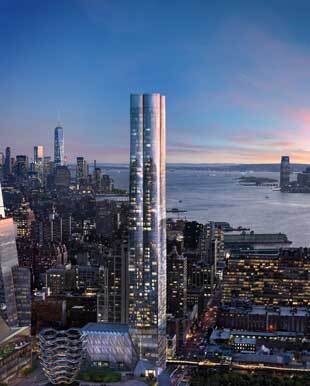
Located in New York City, 15 Hudson Yards is part of Hudson Yards, which is planned as the first LEED Platinum neighborhood. The development will include 14 acres (6 ha) of public open space, more than 100 shops and restaurants, about 4,000 residences, affordable housing, a 750-seat public school, and the inaugural 212-room Equinox Hotel, which opened in July. ()
After years of construction, the first phase of the mammoth 28-acre (11.3 ha) Hudson Yards development in New York City—the largest private real estate project in the city since construction of Rockefeller Center during the 1930s—officially opened in March with 11.9 million square feet (1.1 million sq m) of space in the Eastern Yards area; the second phase of 6.2 million square feet (576,000 sq m) in the Western Yards is scheduled for completion by 2026.
Every day, 125,000 people are expected to live, work, dine, and shop in the new neighborhood developed by New York City–based Related Companies and Toronto’s Oxford Properties Group, the global real estate arm of OMERS, the pension plan for Ontario’s municipal employees. The Hudson Yards development is expected to contribute nearly $19 billion annually to the city’s gross domestic product when finished in 2026.
About 100 miles (160 km) away, the first phase of the ambitious 14-acre (6 ha) Schuylkill Yards innovation district in west Philadelphia—the 1.3-acre (0.53 ha) Drexel Square, a public park adjacent to Philadelphia’s Bulletin Building—opened in June. A partnership between Philadelphia-based real estate investment trust Brandywine Realty Trust and Drexel University, Schuylkill Yards is scheduled to include 6.9 million square feet (641,000 sq m) of residential, commercial, retail, and life science space when completed over the next 20 years.
Farther south, construction began in May on one of the largest urban revitalization efforts in the United States, the long-awaited 235-acre (95 ha) Port Covington on Baltimore’s waterfront. The first new buildings are set to be delivered in fall 2021. At buildout, the first phase of Port Covington is scheduled to include 1.38 million square feet (128,000 sq m) of office space, 337,000 square feet (31,000 sq m) of retail uses, 977,000 square feet (91,000 sq m) of residential space, and 285,000 square feet (26,000 sq m) of hospitality uses.
Hudson Yards, Schuylkill Yards, and Port Covington are only three examples of real estate development driven by expanding and diversifying economies in the country’s Northeast and Mid-Atlantic regions. Economic sectors such as technology, education and medicine, financial services, and media are thriving and gobbling up space in major markets.
New York City Metro Area
Like most of the major metropolises in the region, New York City’s commercial real estate market is flourishing. “We have a wonderful market in New York City right now,” says James D. Kuhn, president of Newmark & Company Real Estate. “Financial services have led expansions in past, but now [the] financial services [sector] is side by side with technology. Life sciences and media are growing, too, and the city is establishing itself as the number-two market in the country, after Silicon Valley, for tech companies.”
Propelling the real estate sector are projects like Hudson Yards, he adds, which led to the extension of the subway’s No. 7 Line from Grand Central Terminal to the West Side and has moved development west and south. Built atop the Metropolitan Transportation Authority’s John D. Caemmerer West Side Storage Yard, the $25 billion complex stretches seven city blocks, bringing together for the first time the West Side and the neighboring districts of Chelsea and Hell’s Kitchen. The neighborhood centers on an expansive public square with a lush landscape and sits atop a raised platform with 30 active train tracks running below.
Planned to be rated the first Leadership in Energy and Environmental Design (LEED) Platinum neighborhood by the U.S. Green Building Council, Hudson Yards will include 14 acres (6 ha) of public open space; more than 100 shops and restaurants; about 4,000 residences, including affordable housing; a 750-seat public school; and the inaugural 212-room Equinox Hotel. (Related owns the Equinox brand of hospitality and fitness facilities.) The centerpiece of the new five-acre (2 ha) public space, named the Public Square and Gardens, is an interactive landmark temporarily known as the Vessel, which is composed of 154 interconnecting flights of stairs (2,500 steps and 80 landings) that offer a one-mile (1.6 km) vertical climbing experience and extraordinary views of Manhattan’s West Side.
Despite accounting for a large part of New York City’s real estate activity, Hudson Yards is only one portion of the current development. Biopharmaceutical company Pfizer is relocating its global headquarters to Tishman Speyer’s the Spiral, a 65-story office tower at 66 Hudson Boulevard on which construction began last year and is expected to be completed in 2022. Brookfield Properties is building the Manhattan West project, an eight-acre (3.2 ha), six-building mixed-use complex in the Hudson Yards area on 31st Street. Multinational professional services firm Ernst & Young has signed on for 675,000 square feet (63,000 sq m) at the 67-story, 2.1 million-square-foot (195,000 sq m) One Manhattan West development, Kuhn says.
“There is tremendous development west and south of the Midtown market, too,” he says. “We know that Apple, Amazon, and Facebook are also looking for large amounts of space. Google continues to expand in NYC, taking most of Oxford Development’s St. Johns Terminal [formerly a freight terminal] and Hudson River Park Trust’s Pier 57, and is adding to their presence at the 2 million-square-foot [186,000 sq m] 111 Eighth Avenue, purchased a few years ago.”
The city’s office market remains healthy in the ninth year of its expansion cycle, says Richard Persichetti, vice president for research, tri-state region, for Cushman & Wakefield. “More than 910,000 jobs were created during this time, and the city now has the highest level of employment ever, with more than 4.6 million workers,” Persichetti says. “Demand for office space is at record levels, as new leasing activity reached a record high in 2018 with 35.9 million square feet [3.3 million sq m] leased, and it continues at a strong pace to start 2019 with 12.1 million square feet [1.1 million sq m] leased through April.”
High-end residential development continues to dominate the Lower Manhattan market. “Former industrial sites in the West Village are being transformed into luxury housing selling at unprecedented prices,” says Arthur A. Linfante, managing director at the commercial real estate valuation, counseling, and consulting services firm Integra Realty Resources in New Jersey. Several notable projects either recently completed, under construction, or planned or proposed include a newly constructed 12-story, 49-unit luxury condominium project on Leroy and West streets completed in 2017; 90 Morton Street, a former printing factory converted into a 12-story luxury condo building by developer Brack Capital; and 860 Washington Street, a 10-story, newly developed commercial office building at Washington and West 13th streets.
Despite the development activity, challenges to the city’s real estate sector include economic and political issues, Kuhn says, noting that Amazon canceled plans to build part of its second headquarters in the Long Island City neighborhood of Queens, citing opposition from state and local politicians. “One challenge in any market in the country is the political headwinds,” he says. “There is usually some opposition anytime there is a large public/private project.”
New England
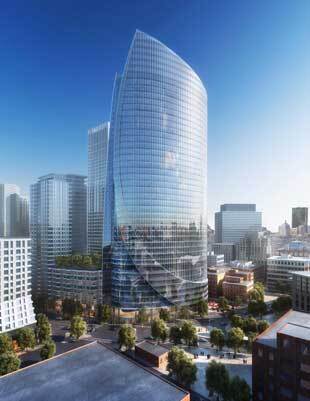
Washington, D.C.’s Carr Properties and National Real Estate Advisors, along with Boston-based HYM Investment Group, began construction on the 43-story, 1 million-square-foot (93,000 sq m) One Congress in Boston in June. The structure is expected to be completed by the end of 2022. State Street Financial has signed up for about half the building’s space. The development was designed by Pelli Clarke Pelli and CBT Architects. (Carr Properties)
Along with New York City, Boston has one of the strongest economies in the country. “We’re hearing that from all the national investors who monitor all the U.S. gateway cities,” says Matthew E. Pullen, executive managing director, capital markets, in the Boston office of Newmark Knight Frank. “The local economy is firing on all cylinders. Venture capital, biotech, eds and meds, and all other sectors continue to perform well. The life sciences sector is expanding rapidly. The demand for lab space is so heavy in Cambridge there is basically zero vacancy.”
Boston’s real estate sector has been healthy because the city has a diverse tenant mix across all asset types, Pullen adds. “Capital markets investors are looking for strong business diversification; it gives them comfort over the long run that there is no overexposure to one industry,” he continues. “Boston differs greatly from Seattle, where Amazon plans to occupy over 14 million square feet [1.3 million sq m], or New York, where shared-office-space giant WeWork is the largest tenant in the city with over 5 million square feet [465,000 sq m].”
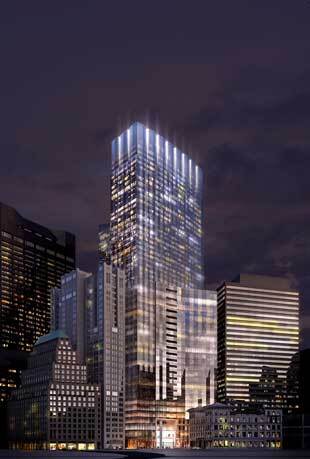
Construction of MP Boston’s Winthrop Center on an acre (0.4 ha) of formerly city-owned land in the center of downtown Boston is expected to be completed in spring 2022. Designed by New York City–based Handel Architects, the $1.35 billion development is the largest private investment for a single project in the city, developers say. It will be Boston’s fourth-tallest building and contain 750,000 square feet (70,000 sq m) of office space and 420 luxury multifamily units. At the base of the building will be the Connector, a civic space open to the public. (Steelblue; MP Boston)
Among the largest developments anticipated are MP Boston’s Winthrop Center, an under-construction skyscraper that will have 1.4 million square feet (130,000 sq m) of commercial, office, and residential space, expected to be completed in fall 2022; and Boston-based HYM Investment Group and Washington, D.C.’s Carr Properties’ construction of the 43-story, 1 million-square-foot (93,000 sq m) One Congress, with State Street Financial taking about half the building.
Strong job growth in Boston’s technology and life sciences sectors is driving this development and has created seemingly insatiable demand for office and laboratory space inside the Route 128 beltway, says Jeremiah Manfra, senior managing director at the Boston office of Integra Realty Resources (IRR).
“Cambridge and Boston lead the region in new inventory and net absorption,” he says. “Amazon leased 430,000 square feet [40,000 sq m] in the Seaport while Verizon committed to 440,000 square feet [41,000 sq m] in new North Station. The region’s job and population growth has expanded the consumer base. Improving retail sales with limited availability drive demand for additional space. Boston has one of the lowest vacancy rates in the country, with most submarkets below 5 percent.”
In the multifamily sector, Manfra says, the Boston area’s reliable job growth combined with limited supply has resulted in steady vacancy improvements and strong rent increases. “However,” he cautions, “a moderating job market and a surge in new supply are likely to soften conditions, particularly for high-end projects already offering increased concessions.”
And with sub–3 percent unemployment, Pullen adds, the region’s constraining factor is the availability of workers. “In addition, affordable housing is a concern,” he continues. “Developers are trying to balance building more affordable housing with not disrupting the fabric of a community.”
In New England overall, economic activity is expected to continue to improve, according to the Federal Reserve Bank of Boston. Through May 2019, employment increased and unemployment rates fell compared with one year earlier, says Riley Sullivan, a senior policy analyst at the Boston Federal Reserve Bank. Payroll employment increased 0.7 percent regionally between May 2018 and May 2019, and all six New England states experienced year-over-year gains in wages and salaries.
“Through the first quarter of 2019, home prices continued to climb both regionally and nationally compared to the same period in 2018,” adds Riley. “Between the first quarter of 2018 and the first quarter of 2019, home prices increased 4.3 percent regionally. All six New England states reported positive house price growth year-over-year. Maine was the only New England state to outpace the national average, at 5.7 percent.”
Real estate activity is a mixed bag in the region. Connecticut’s Fairfield office sector, for example, continues its resilient path of increased absorption and rent increases, while Greater Hartford continues to report negative absorption, says Thomas M. Lescalleet, senior vice president at Bloomfield, Connecticut–based Griffin Industrial Realty. “The state is experiencing continued growth in the industrial manufacturing and warehouse/distribution sectors,” he continues. “There have also been advances in the med-tech sector, albeit this is more prevalent toward New Haven and the downstate area such as Fairfield County.”
Information technology services, insurance tech, biotech/biomed, advanced manufacturing, aerospace, and regional warehousing and distribution are powering the Connecticut economy.
“We continue to build within our New England Tradeport business park in Windsor and East Granby,” Lescalleet adds. “In August 2018, we completed a BTS [build to suit]/lease with Ford for a 234,000-square-foot [22,000 sq m] parts distribution facility in Windsor.”
Construction costs keep rising, Lescalleet notes, although so far increases are being absorbed within deals being done. “It’s a bit stifling, but it is not preventing development,” he says. “State and federal environmental and traffic-control permitting is always an area that could use improvement, and we’d like to see some relief on certain regulations and increased efficiency in processing applications. There’s also much hullabaloo about installing tolls on Connecticut interstate highways. The effects of this on economic development in the region remain to be determined.”
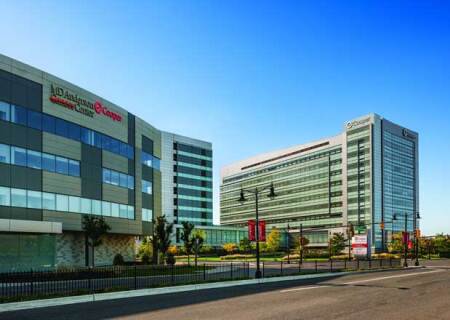
More than $460 million has been invested over the past decade in facilities with over 600,000 square feet (56,000 sq m) of space in Camden’s Cooper Health Sciences Campus, including the Cooper Medical School of Rowan University and the MD Anderson Cancer Center at Cooper. The campus attracts more than 1.6 million patient visits a year.
New Jersey
Northern New Jersey continues to attract the finance, high-tech, and medical industries, spurring development and redevelopment. The state’s proximity to Manhattan and its highly educated labor pool are key drivers, says Paul T. Beisser, senior managing director at the northern New Jersey office of IRR. “Older single-use and multitenanted properties are being repurposed to include continuing-care facilities or medical centers as health care systems expand their service base and seek opportunities to serve an aging demographic,” Beisser says.
One repurposing involves the 2 million-square-foot (186,000 sq m) historic former Bell Labs facility in Holmdel, New Jersey, designed by renowned architect Eero Saarinen during the 1950s. That world-class laboratory produced the transistor, the touch-tone phone—and eight Nobel prizes. In 2007, the complex was abandoned and set for demolition. Somerset Development purchased it in 2013 and began pursuing approvals for an indoor “downtown,” with stores and restaurants lining the ground floor of the impressive atrium, Beisser says.
“Somerset’s vision is to create a ‘work/live/play metroburb’ highlighted by hip amenities and collaborative workspaces,” he says. “With over 900,000 square feet [84,000 sq m] leased, the property has gone from concept to reality as Workwave, Nvidia, Spirent, Acacia Communications, Guardian, and McCann Systems joined a list of more than 30 tenants signing leases in the last two years. Somerset has also partnered with Toll Brothers to develop housing on the vacant portions of the site. In a state with little available development land, this property has opened a lot of eyes about the potential for older, deteriorated office and industrial property stock.”
Logistics and pharmaceuticals remain bright spots in the state’s economy. “New Jersey’s central location and access to New York City make it a natural distribution hub,” says Michael Lachs, a director in the East Brunswick, New Jersey, office of Naples, Florida–based Valbridge Property Advisors. “Additionally, port container volumes have continued to increase, driving more demand. Industrial demand remains strong and development of new multifamily continues at a strong pace, with Jersey City and Hoboken remaining strong overall centers of apartment construction. Retail development is limited to specific real estate plays.”
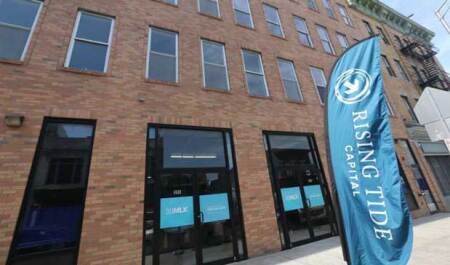
The New Jersey Redevelopment Authority provided a $1.5 million loan for acquisition of the new national headquarters site of Rising Tide Capital, a nonprofit microenterprise development organization in Jersey City. One of the early investments in a newly designated New Jersey Opportunity Zone, 311 MLK opened in May and includes a full-service business accelerator, classrooms, coworking areas, and 5,000 square feet (465 sq m) of commercial space, a courtyard, and 10 units of affordable housing. (Rising Tide Capital)
Redevelopment in suburban areas by communities seeking to create mixed-use developments is on the rise, he adds. “Additionally, court-mandated affordable housing goals are feeding significant levels of suburban apartment development in areas where entitlements were previously near impossible,” Lachs says. “The communities typically feature 15 percent affordable units. In East Brunswick, the town is moving forward on perhaps the largest suburban redevelopment project in the state: River Development Equities plans to build 800 to 1,200 multifamily units plus retail and office uses to create a town center.”
Redevelopment throughout New Jersey is resulting in significant economic resurgence, particularly in urban centers. “I expect this growth to continue and expand with the implementation of the Opportunity Zone program,” says Leslie A. Anderson, president and chief executive officer of the New Jersey Redevelopment Authority (NJRA), based in Trenton. “The Opportunity Zone program is specifically designed to increase economic opportunity by incentivizing new development in low-income urban and rural areas.”
Seventy-five municipalities, representing every county in New Jersey, have received at least one Opportunity Zone, “so we are looking ahead to even more real estate development once the program is fully implemented and projects begin to move forward,” Anderson says. “Unfortunately, without incentives, investors often see low-income areas as too high-risk, which makes it very difficult for needed projects to attract the capital necessary to move forward.”
The NJRA recently invested in an innovative mixed-use redevelopment project in Jersey City, 311 MLK, which is being developed by the nonprofit organization Rising Tide Capital and will serve as its new national headquarters.
“It will also combine affordable housing, classrooms, and coworking space in order to provide underserved entrepreneurs with the support and resources needed to create sustainable businesses that build their community,” Anderson says. “In south New Jersey, we were awarded $20 million in New Markets Tax Credits from the U.S. government, half of which was dedicated to the development of the Ray and Joan Kroc Corps Community Center, a comprehensive community and economic development project that provides health, education, training, and recreation services to low-income seniors, children, and families in Camden.”
Camden continues its renaissance, points out George E. Norcross III, chairman of Cooper University Health Care’s board of trustees. “Crime is down across the city and in every neighborhood; new schools are being built, and student achievement and graduation rates are up; and more than $3 billion of new investment has either recently been completed, is in process, or has been approved and funded and is about to begin.”
National corporate leaders like the MD Anderson Cancer Center at Cooper, Campbell Soup, and Subaru, along with community, business, and government officials, have all made long-term commitments to rebuilding Camden, Norcross says. “That’s why we expect development, and the value of that development, to continue to rise,” he says.
Over the past decade, more than $460 million has been invested in facilities with more than 600,000 square feet (56,000 sq m) of space in the Cooper Health Sciences Campus, including the Cooper Medical School of Rowan University and the MD Anderson Cancer Center at Cooper, notes Kevin O’Dowd, co-president of Cooper University Health Care. “Cooper University Health Care is committed to Camden’s revitalization due to its more than 130-year history serving the residents of the city and region,” he says. Cooper attracts more than 1.6 million patient visits a year to its Camden facilities, he adds.
However, Lauren Gilchrist, senior vice president and senior director of research at JLL, notes that despite consistent public funding dedicated toward developing new jobs, Camden has continued to struggle. “It will take a while for this area to fully realize the vision for a secondary downtown on the Jersey side of the Delaware River,” she says.

An example of the refurbishment trend in Delaware is Fusco Management’s transformation of the College Square Shopping Center in Newark, Delaware, into an active-lifestyle center with 306 multifamily units and 7.7 acres (3 ha) of open space. Construction is expected to start early this fall with completion by 2022, with the multifamily phase being the last component. The project was originally a horse track. It was converted into a shopping center during the early 1980s. (Fusco Management)
Delaware
The Delaware development market continues to move at its own pace, producing steady population and job growth centered in the suburban areas. “The overall unemployment rate statewide is just under 3.3 percent in the 2019 first quarter, down from 3.8 percent at midyear 2018,” says Albert R. (Chip) Hughes, senior managing director in IRR’s Philadelphia office. “A bright spot on the horizon is the resurgence of residential single-family construction, which is active in the lower counties, although at a pace substantially below the precrisis levels.”
Adaptive use is a growing trend, says Jay L. White, president and founder of Wilmington’s Apex Realty Advisory. “Fusco Management has approvals for the redevelopment of the College Square Shopping Center in Newark to replace the existing shopping center with a walkable, bikable, active-lifestyle mixed-use retail and residential apartment complex on 46 acres [19 ha],” he says. “The community will have two four-story apartment buildings containing 305 units to be marketed toward young professionals and empty nesters, plus 325,000 square feet [30,000 sq m] of retail and restaurant space. The general market trend in north Delaware is to redevelop older, obsolete office campuses or shopping centers into mixed-use, work/live/play communities.”
Developer Delle Donne & Associates of Newark, Delaware, is proposing to rezone 79 acres (32 ha) of the former Astra Zeneca North Campus in suburban Wilmington and plans to redevelop a majority of the site for mixed-use redevelopment, including 335 apartment units, a luxury hotel, a fitness center, and a retail complex totaling 835,000 square feet (78,000 sq m) of space, with Astra Zeneca continuing to lease about 400,000 square feet (37,000 sq m) as the anchor, White says.
Wilmington also has a number of hotels planned or under construction, White says. These include Buccini/Pollin Group’s six-story, 120-room Homewood Suites on the Wilmington Riverfront; a seven-story, 114-room Hyatt Place hotel and banquet center—a joint venture between Onix Group and Big Fish Restaurant Group; and the planned conversion by Driftwood Acquisition & Development Group, of Coral Gables, Florida, of a recently purchased 10-story former office building to serve as a suites hotel that is expected to be Wilmington’s first Opportunity Zone development.
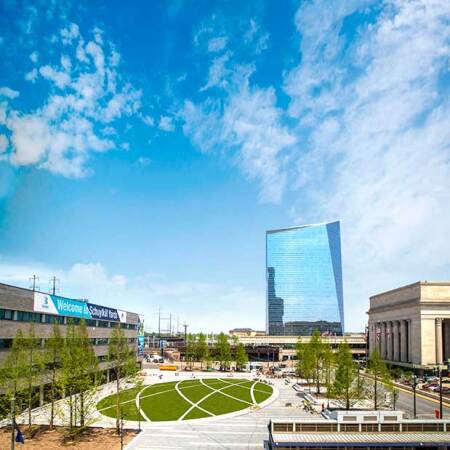
The 1.3-acre (0.5 ha) Drexel Square, a public park adjacent to Philadelphia’s 30th Street Station and the first phase of the 14-acre (5.7 ha) Schuylkill Yards mixed-use neighborhood in West Philadelphia, opened in June. Master planned and developed by Philadelphia-based Brandywine Realty Trust in partnership with Drexel University, Schuylkill Yards is scheduled to include 6.9 million square feet (641,000 sq m) of residential, commercial, retail, and life sciences space when completed over the next 20 years. (Brandywine Realty Trust)
Pennsylvania
With the macro-economic climate providing a backdrop of relative stability thanks to low unemployment, escalating wages, and moderating interest rates, the regional Philadelphia real estate market continues its nine-year run of solid performance. Prospects for the city’s real estate sector continue to be bright in view of ongoing economic growth, lack of new construction, limited availability of large blocks of office space, and demand for new housing in the urban core.
“While some believe a long bull market is unsustainable, the tailwinds of the healthy macro economy should enable the region to post modest growth for the balance of this year and into 2020,” says Paul J. Commito, senior vice president of development at Brandywine Realty Trust. “Food service, facilities, and uniform services provider Aramark’s new headquarters is slated to open later this year, and Drexel Square—the first completed project within our master-planned Schuylkill Yards development—is finished. The Pavilion, Penn Medicine’s new, innovative hospital facility, is under construction and scheduled for delivery in 2021.”
Philadelphia’s hospitality sector continues to demonstrate strong growth and expansion, with more than 16 new hotels forecast to open by 2020. “In the office sector, we expect to see a steady demand in the region for new and innovative workplace environments, while upstart growth from tech and life sciences companies will elevate the existing commercial office foundation composed of long-established institutions such as eds and meds, financial services, and pharmaceutical companies. Both Center City and University City Philadelphia are still underserved by brick-and-mortar retail, as there seems to be more than adequate demand for new, viable retail in high-traffic urban areas.”
Although some macroeconomic signs are beginning to point toward a slowing of the economy overall, indicators still suggest low inflation and rapid job growth, says Gilchrist of JLL. “The Philadelphia office market will continue to feel strong momentum with the potential to see new build-to-suit developments that are a function of old office stock and limited blocks of trophy space, particularly in high-rise floors,” she says. “The multifamily market will deliver a significant number of new units this year, then taper off substantially, so we expect some overhang of supply, but past trends suggest the CBD [central business district] is well positioned to absorb these units.”
The 60-story, 1,121-foot-tall (342 m) Comcast Technology Center, developed by Liberty Property Trust, opened last year—the latest addition to Comcast’s global headquarters campus, joining the adjacent Comcast Center, 2 Logan, 3 Logan, and Centre Square in the heart of Philadelphia. The new building serves as the dedicated home for the company’s growing workforce of more than 4,000 technologists, engineers, and software architects, as well as the operations of local broadcast television stations NBC10 and Telemundo62 and an incubator space for local technology startups at LIFT Labs.
Even so, very little trophy office space is available, says Anne Cummins, chief operating officer at Philadelphia-based Gattuso Development Partners. “New companies are moving in and existing companies [are] expanding. There are very few big chunks of space available, period. A few large tenants are looking to move within the market, and not too many big blocks of quality space are available, if any.”
One project moving toward completion is the Fashion District Philadelphia, which is a gut rehabilitation and redevelopment of the Gallery shopping mall, according to Peter Angelides, a principal at Econsult Solutions Inc. of Philadelphia, which provides economic development and analytical services.
“The project spans three city blocks and will include a broad selection of popular retail chains,” he notes. “More important, the building will have a much stronger street presence on Market Street than the earlier incarnation and has the potential to move the transformation of that part of town forward tremendously.”
Residential development, including multifamily and single-family rowhouses, is strong, Angelides adds. “Parking lots in Center City continue to disappear in favor of building projects, and there is a steady flow of residential construction in the neighborhoods surrounding Center City,” he says.
The Philadelphia multifamily market has never been a boom-or-bust market, says Bradley Korman, co–chief executive officer of Korman Communities, based in Plymouth Meeting, Pennsylvania, one of the largest owners and managers of multifamily properties in the region. “Dallas may bring 85,000 units on line in a five-year period, or Washington, D.C., may add 36,000 units while we’re doing 19,000 units,” he notes. “We never really go over our skis too much. Multifamily continues to be a good performer.”
International investors also are showing more interest in Philadelphia. “Fifteen years ago, we were looked at as a second-tier city,” he says. “That has changed. Investors now are taking notice of Philadelphia, and we have a lot of great properties with the amenities that are offered in New York, San Francisco, and D.C. Young people are looking to stay [in] or move to Philadelphia and are attracted by our new multifamily stock.”
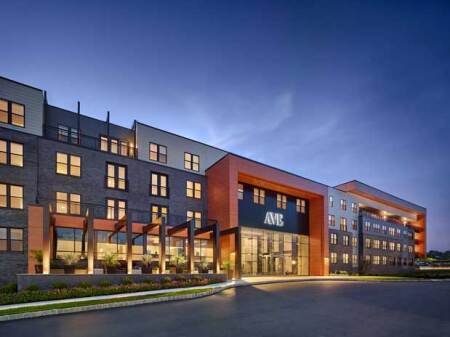
Korman Communities of Plymouth Meeting, Pennsylvania, opened AVE King of Prussia, a 275-unit extended-stay multifamily community at the Village at Valley Forge in 2018. The complex features furnished and unfurnished units with amenities such as a movie theater with surround sound, a dog wash station, bike storage and repair stations, and electric vehicle charging stations. (Halkin Mason Photography)
One of the biggest developments in the metropolitan area is the Village at Valley Forge near the region’s famed King of Prussia Mall, Korman adds. “The new property is entitled for over 2,500 residential units, 500,000 square feet [46,000 sq m] of retail, two hotels, and a million square feet [93,000 sq m] of mid-rise office and health care space,” he says. “It has become the place to live in the suburbs and a model for how a town center can thrive in our region.”
Not all is clear sailing in the Philadelphia region, though. Land planning, zoning, and entitlement are highly fractured, Angelides points out. “Every municipality sets its own rules and coordinates with other municipalities only when necessary,” he says. “The broad trends of the last 50 years, the orderly conversion of greenfields to low-density development on the fringe of the region, continues, albeit at a reduced pace compared to previous years. So open-space consumption/preservation is an issue.”
Although Philadelphia’s zoning code was overhauled several years ago, real estate taxation uncertainty has thrown a massive wrench into the system, Gilchrist adds, including the potential elimination of tax abatements. “Nonuniform assessments over the past two years have caused major property value spikes,” she says, “and major tax bill spikes as well, which the market is struggling with.”
Gentrification, historic preservation, and affordable housing also are issues that have come to the fore. “While these issues are not uncommon, particularly in the urban context, it certainly provides a heightened awareness in the communities where new development is planned,” Commito says. “Amidst the region’s successful development track record during this extended growth period, it is important that public and private entities take a solution-oriented approach to these issues.”
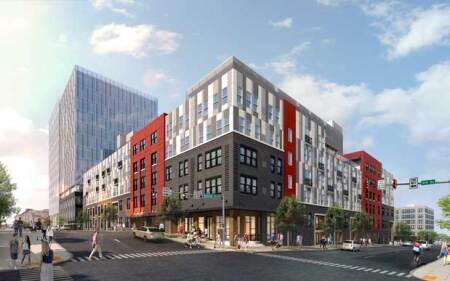
City Center Investment Corporation’s Center Square Lofts, expected to be completed in fall 2019, includes two premier residential buildings with 264 units in downtown Allentown, Pennsylvania. The development will offer 20,000 square feet (1,900 sq m) of indoor and outdoor amenity space, including a rooftop deck, refrigerated package delivery, a fitness center, and an outdoor pool. (©J Davis Architects)
Real estate activity is also strong in the neighboring Lehigh Valley, known officially as the Allentown–Bethlehem–Easton, Pennsylvania–New Jersey metropolitan statistical area (MSA), with Allentown as the largest city. “It’s the fastest-growing MSA in Pennsylvania and the northeast United States,” says J.B. Reilly, president of City Center Investment Corporation (CCIC), which is developing numerous projects with the potential to transform downtown Allentown. “Lehigh Valley’s high quality of life, lower cost of living, close proximity to New York City, and solid availability of educated talent pool were all recently validated by human resources and payroll provider ADP’s decision to locate up to 1,600 jobs in a new national sales center being built in downtown Allentown and scheduled to be occupied this summer,” Reilly says.
CCIC has completed over $500 million of office, apartment, and hospitality projects during the past four years in downtown Allentown and has started construction of several additional office and apartment projects totaling over $200 million. “Strong multifamily demand is fueling several new apartment projects, with more than 800 scheduled to be open by next year,” he adds. “We see continued growth because of low vacancy rates across all property sectors and continued population and employment growth projected.”
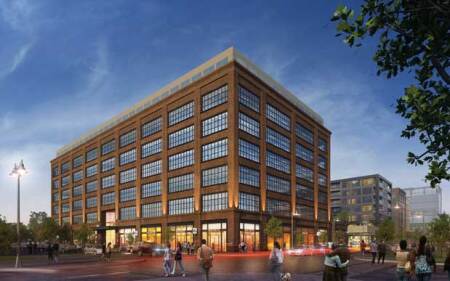
One of the largest urban revitalization efforts in the United States, the 235-acre (95 ha) Port Covington on Baltimore’s waterfront broke ground on the next phase of the development in May. The development includes 150 E. Cromwell Street, a 210,000-square-foot (20,000 sq m) office building with 10,000 square feet (929 sq m) of ground-floor retail space that is expected to begin construction later this year, with completion in 2021. (Weller Development Company)
Maryland
Baltimore’s economy continues to hum, with not only continued waterfront development and megaprojects such as Port Covington, but also activity in the city’s varied neighborhoods. “We’re seeing a lot of redevelopment and reuse of vacant, underutilized industrial buildings and historic properties in our neighborhoods,” says Kim Clark, executive vice president of the Baltimore Development Corporation. “We have a lot of neighborhood-focused redevelopment of various types of properties.” These include public markets that have been in communities since the 1800s and some old schools being redeveloped as live/work spaces for artists.
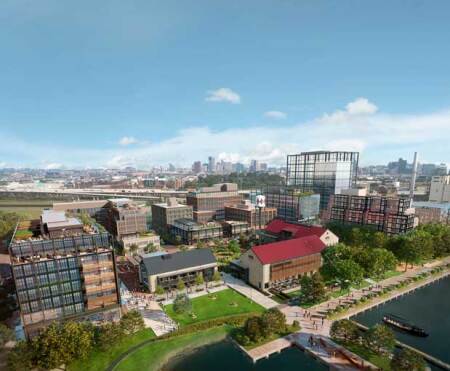
Weller Development Company has 3 million square feet (279,000 sq m) of mixed-use development space underway in Port Covington, including residential, office, market, retail, and public space. Port Covington will feature up to 40 acres (16 ha) of parks and green space, 2.5 miles (4 km) of restored waterfront, and 18 million square feet (1.7 million sq m) of new, mixed-use space when buildout is completed over the next two decades. (Weller Development Company)
In Greenmount West, a neighborhood in the state-designated Station North Arts District of Baltimore—which includes a mix of low-, middle-, and high-income families—three large warehouse buildings that were vacant for 20 years have been repurposed, she says, including one converted to a charter school.
Much of today’s neighborhood development activity has been city and community driven, with communities finding development possibilities without displacing residents. “A lot of the developments have been framed around gathering spaces—not necessarily parks or open space, but places where residents meet,” Clark adds. “It’s social-impact development—development without displacement, looking at what works and keeping the community as a whole. It’s a marriage of economic and community development. It used to be communities didn’t recognize economic development, and economic developments didn’t really recognize communities. The communities that have long been looked over and bypassed recognized this.”
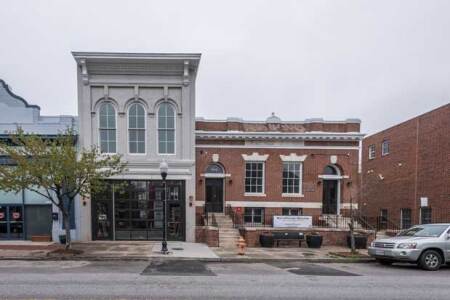
Walter’s Bathhouse and the adjoining fire station have been redeveloped as a mixed-use development in Baltimore’s Pigtown neighborhood by SA+A Development, which focuses on the creation of affordable housing; Ernst Valery Investments Corp.; and Bricklayers and Allied Craftworkers Local 1 of Maryland, Virginia, and Washington, D.C. The property, acquired from the Baltimore Development Corporation, was transformed into eight multifamily units and a Milk & Honey Market. The two buildings were originally a Baltimore city fire station constructed in 1872 and a public bathhouse built in 1901. The development opened in May. (Results Realty LLC)
No doubt the biggest news in Baltimore is the start of Port Covington. When the entire Port Covington project, a public/private partnership between the city of Baltimore and Port Covington developers, is built out, it will feature up to 40 acres (16 ha) of parks and green space, 2.5 miles (4 km) of restored waterfront, and 18 million square feet (1.7 million sq m) of new, mixed-use space.
Weller Development Company of Baltimore is the lead developer, along with joint owners Plank Industries and Goldman Sachs Urban Investment Group. Kevin Plank, founder and chief executive officer of Under Armour, played a key role in getting development plans started but has not specified a timeline for the company’s headquarters on the site.
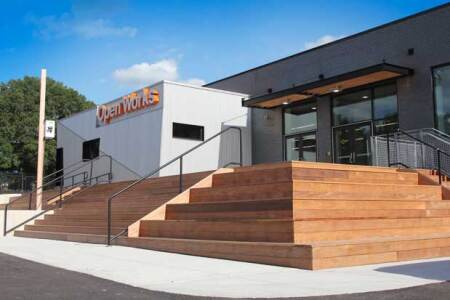
Baltimore Arts Realty Corp.’s 34,000-square-foot (3,000 sq m) Open Works, often described as an incubator for Baltimore’s creative economy, opened in 2016. The structure once housed a Railway Express Agency office but now is home to entrepreneurs who rent workspaces and can use welding and electrical equipment, machines and saws, the paint room, and the sewing shop. Open Works, founded in 2016 to rebuild Baltimore’s manufacturing economy, is now one of America’s largest nonprofit maker spaces. (Open Works)
Thanks to its prime Mid-Atlantic location, strong economy, and large population base, Baltimore has bright prospects, says Dennis Duffy, senior managing director at IRR in Washington, D.C. He adds that the area’s prospects could brighten considerably if plans go forward for a proposed 40-mile (64 km) superconducting magnetic levitation train system [maglev train] that would take passengers from Baltimore to the nation’s capital in 15 minutes.
“The high-speed maglev train project between Baltimore and Washington is gaining momentum,” he says. “We would expect that formerly low-density or residentially zoned land will, of necessity, require greater density to be economically viable to attract the future demands of modern, more technically reliant industry. While the maglev is years away, the recent arrival of Amazon in Northern Virginia is expected to spark residential demand on the Maryland side of the river as it is generally more affordable than the Virginia side. Once the maglev project is fully approved and underway, the area between Baltimore and D.C. will be prime territory for a greater tech industry location, at a more affordable cost.”
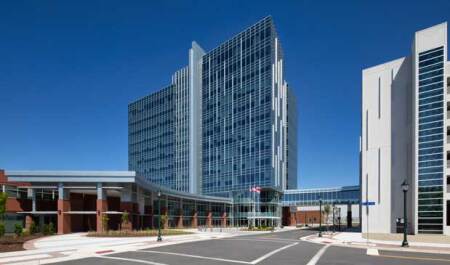
Saunders + Crouse Architects of Virginia Beach designed the DollarTree office tower built by Clancy & Theys in the first phase of the Summit Pointe development in Chesapeake, Virginia. The 12-story, 510,000-square-foot (47,000 sq m) structure opened in 2018 and will employ 2,300 people once it is fully operational. Construction of the second phase of Summit Pointe began in May and will include upscale apartments, restaurants, retail uses, and office space. (Saunders + Crouse Architects)
Virginia
The Hampton Roads (the Virginia Beach–Norfolk–Newport News MSA) economy is on the mend thanks to an improving shipbuilding sector and a growing new “digital port,” says Tom O’Grady, director of business development at Clancy & Theys Construction in Newport News. In January, the U.S. Navy awarded Huntington Ingalls Industries’ Newport News Shipbuilding a $14.9 billion contract to build two aircraft carriers. At the same time, the region is becoming a major digital port with transatlantic fiber-optic cables, including one to be used by Microsoft and Facebook, from Virginia Beach to Bilbao, Spain, 4,000 miles (6,600 km) away; a second cable from Virginia Beach to Brazil; and a planned third high-speed subsea cable that would connect the United States and South Africa.
“We had not experienced job growth like the other metro areas, and Hampton Roads hasn’t rebounded as quickly from the 2008–2009 recession, but we are gradually growing stronger as time moves on,” O’Grady says. “The three pillars of our economy are defense, the Port of Virginia, and tourism. All three are growing at a strong clip, so the outlook for next 12 to 18 months is very strong.”
In the Greenbrier submarket of Chesapeake, the Summit Pointe Chesapeake development is now home to the new $100 million DollarTree headquarters, he says. “The Town Center of Virginia Beach also has been a great success, with two new hotels ready to open soon. The Newport News City Center has major activity: residential and commercial plumbing distributor Ferguson Enterprises is building 260,000 square feet [24,000 sq m] of office space expected to be completed in 2020.”
In central Virginia, the strong Richmond economy is reflected in all sectors of the local real estate market. “Job growth is steady, as over 90,000 jobs have been added since 2010, and the unemployment rate dropped to 2.8 percent at year-end from 3.4 percent a year earlier,” says Ken Brown, senior managing director in IRR’s Richmond office. “The office, industrial, retail, and multifamily sectors are all in the expansion phase. High levels of multifamily development, both in the central city and throughout the suburbs, are being readily absorbed. Class A occupancy rates range from 93 percent in town to 95 percent in suburban Chesterfield, Henrico, and Hanover counties.”
Leading the industrial development activity is Facebook’s new 900,000-square-foot (84,000 sq m) data center in the White Oak Technology Park near Richmond International Airport, he says. “Regional infrastructure enhancements like the ultra-high-speed trans-Atlantic fiber-optic telecommunication cables that connect to the domestic grid in Hampton Roads and solar power generation initiatives have paved the way for such developments,” Brown says. “The Richmond area’s central Eastern Seaboard location has also made it a key distribution center; it is home to two 1 million-square-foot [93,000 sq m] Amazon fulfillment centers.”
Dominion Energy’s new 20-story, 900,000- square-foot (84,000 sq m) office tower in downtown Richmond is nearing completion, and the company has announced that it intends to proceed with development of an adjacent building. “New creative space is being added in adaptive use projects throughout the city, and new projects are planned for close-in suburban projects like Gumenick Properties’ Libbie Mill,” Brown says. “The Short Pump Town Center in western Henrico County remains the area’s leading retail center, and the West Broad Street corridor from the mall to the Goochland County line will be the nexus of new retail development.”
Some of the brightest spots in the Richmond economy are medical and health care firms, industrial uses with data centers and research facilities in particular, and multifamily and senior and active-adult residential development, says Andrew M. Condlin, a member of the Richmond office of law firm Roth Jackson Gibbons Condlin, who focuses on commercial real estate and land use laws. “Entertainment and hospitality service industries also remain strong, with sports tourism often a central focus by localities,” he says.
Interest in the development of new hotels is expanding, and the market for existing hotels remains strong. “Entertainment and service uses also continue to be performing well in all areas of Richmond,” Condlin says. “Localities are continuing to encourage more mixed-use development opportunities, including the provision of form-based zoning codes, reduced parking requirements, and higher by-right residential densities.”
Challenges remain, however. “Sea-level rise and recurrent flooding are overarching issues that will need to be addressed holistically,” says O’Grady of Clancy & Theys. “Old Dominion University is leading the charge. Shopping malls such as Military Circle in Norfolk and Chesapeake Square in Chesapeake have very high vacancy rates and are searching for best practices on how to reimagine their future.”
Barring an unforeseen global economic jolt, New York, New England, and the Mid-Atlantic region are expected to report healthy economic and robust real estate activities going forward.






